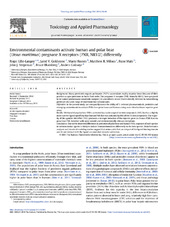| dc.contributor.author | Lille-Langøy, Roger | eng |
| dc.contributor.author | Goldstone, Jared | eng |
| dc.contributor.author | Rusten, Marte | eng |
| dc.contributor.author | Milnes, Matthew R. | eng |
| dc.contributor.author | Male, Rune | eng |
| dc.contributor.author | Stegeman, John J. | eng |
| dc.contributor.author | Blumberg, Bruce | eng |
| dc.contributor.author | Goksøyr, Anders | eng |
| dc.date.accessioned | 2015-08-17T10:53:32Z | |
| dc.date.available | 2015-08-17T10:53:32Z | |
| dc.date.issued | 2015-04-01 | |
| dc.identifier.issn | 0041-008X | en_US |
| dc.identifier.uri | http://hdl.handle.net/1956/10282 | |
| dc.description.abstract | Background Many persistent organic pollutants (POPs) accumulate readily in polar bears because of their position as apex predators in Arctic food webs. The pregnane X receptor (PXR, formally NR1I2, here proposed to be named promiscuous xenobiotic receptor) is a xenobiotic sensor that is directly involved in metabolizing pathways of a wide range of environmental contaminants. Objectives In the present study, we comparably assess the ability of 51 selected pharmaceuticals, pesticides and emerging contaminants to activate PXRs from polar bears and humans using an in vitro luciferase reporter gene assay. Results We found that polar bear PXR is activated by a wide range of our test compounds (68%) but has a slightly more narrow ligand specificity than human PXR that was activated by 86% of the 51 test compounds. The majority of the agonists identified (70%) produces a stronger induction of the reporter gene via human PXR than via polar bear PXR, however with some notable and environmentally relevant exceptions. Conclusions Due to the observed differences in activation of polar bear and human PXRs, exposure of each species to environmental agents is likely to induce biotransformation differently in the two species. Bioinformatics analyses and structural modeling studies suggest that amino acids that are not part of the ligand-binding domain and do not interact with the ligand can modulate receptor activation. | en_US |
| dc.language.iso | eng | eng |
| dc.publisher | Elsevier | en_US |
| dc.rights | Attribution CC BY-NC-ND | eng |
| dc.rights.uri | http://creativecommons.org/licenses/by-nc-nd/4.0/ | eng |
| dc.subject | In vitro ligand activation | eng |
| dc.subject | Pregnane X receptor | eng |
| dc.subject | Polar bear | eng |
| dc.subject | Human | eng |
| dc.subject | Environmental pollutants | eng |
| dc.title | Environmental contaminants activate human and polar bear (Ursus maritimus) pregnane X receptors (PXR, NR1I2) differently | en_US |
| dc.type | Peer reviewed | |
| dc.type | Journal article | |
| dc.date.updated | 2015-08-17T10:46:05Z | |
| dc.description.version | publishedVersion | en_US |
| dc.rights.holder | Copyright 2015 The Authors | en_US |
| dc.identifier.doi | https://doi.org/10.1016/j.taap.2015.02.001 | |
| dc.identifier.cristin | 1248631 | |
| dc.source.journal | Toxicology and Applied Pharmacology | |
| dc.source.40 | 284 | |
| dc.source.14 | 1 | |
| dc.source.pagenumber | 54-64 | |

